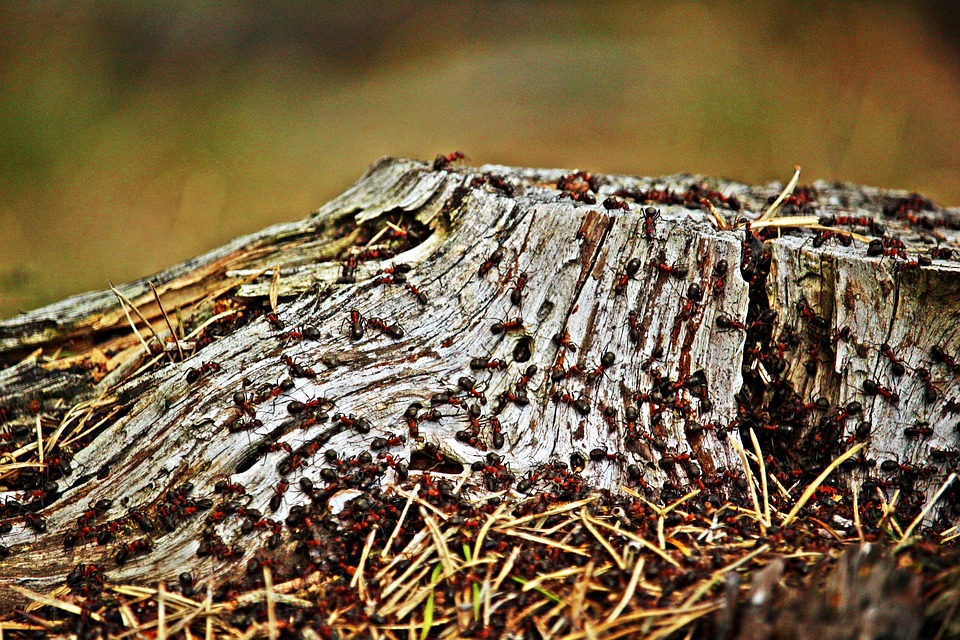It is easy to imagine that the lives of the ants resemble our own. An ant might feel, as people sometimes do, lost in the crowd. If you look at a city from far away, you see a hive of activity: people going back and forth from home to job and collecting packages of food and things produced by other people, things to be stored in their chambers or turned into garbage taken away by other people. Each person is a tiny speck in the flow of a system that no one has much power to change.
Our fascination with ants has led to engaging stories about them, from the Iliad’s Myrmidons to Antz’s Z, as well as a growing body of research by biologists. Though the ant colonies of fable and film often are invested with the hierarchical organization characteristic of human societies, a real ant colony operates without direction or management. New research is showing us how ant colonies get things done without anyone being in charge. Ants, it turns out, have much to teach us about the decentralized networks that operate in many biological systems, in which local interactions produce global behavior, without the guidance of any central intelligence or authority.
Many of our stories about ants concern how hard they work and how they are reconciled to the anomie of life as a pawn in a larger system. Sometimes we imagine that the ants like it that way. Proverbs 6:6 admonishes the sluggard to emulate the hard-working ants. In Aesop’s fables, the ants show perseverance and foresight. Homer’s Iliad tells of a race of myrmidons, ants transformed by Zeus into selfless human soldiers. T. H. White, writing during the Cold War, sent the young King Arthur into an ant colony that is a totalitarian hell, with microphones blaring commands.
Recent animated films about ants are Hollywood tales of corporate life. Antz (1998) begins with Z, the misunderstood ant worker voiced by Woody Allen, complaining to his therapist that he doesn’t feel appreciated as an individual. In Antz, as well as in A Bug’s Life (1998), ants triumph through their personal achievements. The Ant Bully (2006) takes this further. A bullying, self-centered boy is transformed into a caring, considerate one by becoming a loyal worker in an ant business where teams of workers compete to gain the most profit for the company.
These films substitute descriptions of human societies for those of social insects. For example, workers and management, foremen and generals, are all male. There is romance involving female princesses and queens, who don’t do much, but have some maternal authority. In real ant colonies, by contrast, the males are alive for a few days or weeks, only long enough to mate and then die, and the workers are female. Most important, these fictional colonies are home to bureaucrats, officers, and royalty. In real colonies there is no authority. As the writer of Proverbs chapter 6 puts it, the ant, “having no chief, overseer or ruler, gathers the harvest.”
Ant colony organization is mysterious but effective, so it is easy to attribute extra powers to ants. In most horror movies about ants, the ants are not just creepy—they are somehow better organized than the bumbling humans. In Them! (1954) radiation near a nuclear testing site in New Mexico produces giant ants who take over the sewer system of Los Angeles. The ants sense things that people can’t, and their diabolical queen gives them instructions that allow them to outwit the scientist, carry off his daughter (pillbox hat and all), and almost defeat the handsome policeman who sets out to rescue her.
Phase IV (1974) takes our awe of ant organization even further. Scientists have set up an ecoysystem inside a dome. Ants get into the dome, as real ants did Biosphere 2, the artificial ecosystem in Arizona. In the film the ants chew through electrical wires, as real ants sometimes do, such as the Paratrechina ants currently disrupting electrical systems in Texas. But the ants in Phase IV chew through the wires with a purpose: to manipulate the computer. They take over the project by causing the computer to overwhelm the less electronically savvy scientists. This seems almost plausible. If a lot of little insects can together build enormous nests, find your cat’s food no matter what you do, and reproduce so successfully that a third of the biomass of the world’s tropical forests is composed of their bodies, surely they can control a computer, too.
Even scientists are prone to imagine that the organization of ant colonies gives them extra power. Consider the popular idea of the “super-colony” of the invasive Argentine ant. This species began to travel from Argentina in the early twentieth century, mostly with shipments of sugar. The Argentine ant is established and has wiped out the native ants everywhere with a climate similar to that of its native range: the California coastline, the Mediterranean coastline, some areas of South Africa, Australia, Hawai’i, and elsewhere.
In the early 1990s a group of scientists at the University of California, San Diego introduced the notion that Argentine ants form a super-colony, one enormous colony stretching throughout California. Scientists studying Argentine ants on the French Riviera and Italian coastlines took up the idea, which then made its way into some sensational “scientific” headlines: “Ant supercolony dominates Europe,” BBC News declared in 2002. The BBC upped the ante in 2009: “Ant mega-colony takes over world.”
The force of the idea of the super-colony came from the observation that Argentine ants from different nests rarely fight with each other. The super-colony evoked an image of huge numbers of small brown ants pouring into California from Latin America. The fact that the ants didn’t fight with each other suggested that somehow they were all linked together, and that united they could defeat all the native ants in their path.
But the lack of fighting among Argentine ants does not reveal a collective purpose. Like all ants, the experience of an Argentine ant is largely olfactory and tactile; most of the 11,000 species of ants have very poor vision. An ant is coated with a layer of grease (cuticular hydrocarbons) that carry its colony’s odor, and ants of some species react aggressively to the odor of a different colony. Argentine ants, like some other ant species, are not very sensitive to small differences in odor. However, scientists recently have discovered that, with sufficient differences, Argentine ants will fight after all. In a laboratory working to develop pesticides, a technician fed some Argentine ants a German cockroach. The result was both unintended and exciting: the cockroach’s odor was incorporated into the ants that ate it, and they were attacked by other Argentine ants that had not eaten the cockroach. Argentine ants are notorious for coming into buildings and for feasting from outdoor garbage cans. When it comes to fighting among Argentine ants, what matters may be whether they have been sharing the remains of Big Macs, not their genetic origins.
In fact there is no functional super-colony of Argentine ants, no single giant colony stretching for miles, much less across the globe. Argentine ants have distinct colonies that reproduce independently and do not share resources. Like many other ant species, their colonies consist of many nests, linked to each other by trails of ants. Most of these multi-nest species are obscure, not worldwide invaders. My colleagues and I found that Argentine ant nests only 200 meters apart are genetically distinct, which means that ants from one colony don’t mix with those of the colony next door. We also found that ants from one colony don’t share food with ants from another. The metaphor of a super-colony expresses our recognition that unity generates power. But the spread and ecological impact of Argentine ants is not due to cohesion between colonies; it seems to have other causes—including their ability to compete with native ants for the use of the sugary excretions of scale insects (a type of insect that sucks the sap from plants).
Understanding how ant colonies actually function means that we have to abandon explanations based on central control. This takes us into difficult and unfamiliar terrain. We are deeply attached to the idea that any system of interacting agents must be organized through hierarchy. Our metaphors for describing the behavior of such systems are permeated with notions of a chain of command. For example, we explain what our bodies do by talking about genes as “blueprints,” unvarying instructions passed from an architect to a builder. But we know that instructions from genes constantly change, as genes turn off and on in response to local interactions among cells.
Ant colonies, like genes, work without blueprints or programming. No ant understands what needs to be done or what its actions mean for the welfare of the colony. An ant colony has no teams of workers dedicated to fighting or foraging. Although it is still commonly believed that each ant is assigned a task for life, ant biologists now know that ants move from one task to another. How does an ant decide which task to do and when to do it? We all know that where there is a picnic, there will be ants. So what determines which ants go to the picnic, and how many show up?
Colonies are regulated by networks of interaction. Ants respond only to their immediate surroundings and to their interactions with the other ants nearby. What matters is the rhythm of interactions, not their meaning. Ants respond to the pattern and rate of their encounters with each other, as well as to the smells they perceive in the world, such as the picnic sandwiches.
Among harvester ants—the ants I know best—the important interactions are brief antennal contacts. An ant uses the rate at which it meets other ants to decide what to do. If you have ever watched ants closely, you have seen them touch antennae. When a harvester ant moves from tasks inside the nest to tasks outside, its odor changes, so an ant’s hydrocarbons identify its current task as well as its colony. To test how brief antennal contact influences ant behavior, my colleague Michael Greene and I presented ants with little glass beads coated with the odor of ants who are performing a particular task. Some of the beads smelled like patrollers, the first ants to go out of the nest each morning and travel around the colony’s foraging area. The safe return of the patrollers, at a rate of about ten ants per second, stimulates the first foragers to go out to search for food. When foragers meet beads bearing the hydrocarbons of patrollers, at the correct rate, they leave the nest. This experiment shows that an ant’s rate of brief antennal contact influences what the ant does next.
And what an ant does next may not be much at all. Contrary to another of our beloved myths about ants, told by Aesop, Homer, and the writer of Proverbs 6:6, many ants don’t work very hard. In a large harvester-ant colony, about a third of the ants at any time are hanging around doing nothing. As Mark Twain put it, this “will be a disappointment for the Sunday schools.” Because colony behavior is regulated by a network of interactions, inactivity might have its uses. Idle ants may act as a buffer to dampen the interaction rate when it gets too high. My colleagues and I have found that ants will move around to adjust their interaction rate—either they seek each other out when there are few ants, or they avoid each other when crowded. Sometimes interactions create positive feedback, as when ants go out to forage in response to interactions with foragers bringing food back to the nest. But eventually this could lead ants to search for food when there is none left. The colony may need some inert ants, unlikely to be stimulated by interactions, to buffer the network.
The tension between what we really know about ants—that no ant directs the behavior of another—and the familiar metaphors for social organization, permeates not only our stories about ants, but also the scientific study of ants. These contradictions appear in biologist E. O. Wilson’s novel Anthill (2010), which tells the story of an extended war involving three ant colonies. Wilson uses ants that are very different from Aesop’s to draw a similar moral. In Anthill the ants are greedy, and their lack of foresight and unchecked consumption depletes their resources and causes them to perish.
Anthill blurs the lines between science and fiction. Wilson’s scientific account of colony organization quickly becomes entangled in contradictions as he depicts ants as the passive and uncomprehending pawns of their mother, yet, at the same time, making decisions based on an almost-human intelligence and sophisticated understanding of their colony’s history and what it means for their future. Many times the ants are described as programmed, propelled by an “instinct machine.” At other times, the ants are said to have agency but are compelled to sacrifice for their mother, the “fountainhead” of the colony, and go obediently to their deaths. These little robots whose every move is dictated, sometimes by some internal program and sometimes in allegiance to the queen, are also, by contrast, savvy and purposeful enough to plan out their tasks in advance and engage in military strategy.
A real ant colony is not a society of scheming, self-sacrificing individuals. It is more like an office that communicates by meaningless text messaging in which each worker’s task is determined by how many messages she just received. The colony has no central purpose. Each ant responds to the rate of her brief encounters with other ants and has no sense of the condition or the goals of the whole colony. Unlike the ants in Anthill, no ant really cares if the queen dies.
Ant colonies are not the only complex systems that function without central control. Brains, too, have no chain of command. They rely on interaction networks among neurons. It is an open scientific question whether the analogy between an ant colony and a brain is more than superficial, and, in Anthill, Wilson comes up against the questions we can’t answer about either. He explains that ants are very intelligent because they can learn to run a maze, and that all this ant intelligence, added up, makes the colony smart. But later we hear that “the colony intelligence was distributed among its members, in the same way human intelligence is distributed among the gyri, lobes and nuclei of the human brain.” The problem is that no one really knows how intelligence is distributed in the human brain, and the gyri, lobes, and nuclei of a brain can’t learn to navigate a maze.
The outstanding scientific questions about ants and brains are the same ones we have about many other biological systems that function without hierarchy, such as the immune system, the communities of bacteria in our bodies, and the patterns we see in the diversity of tropical forests. For all of these systems, we still don’t understand how the parts work together to produce the dynamics, the history, and the development of the whole system.
When we figure out how ants run their colonies, will we learn anything that will help us to run human society?
It is true that as people become more as we rely more on ant-like interaction networks such as text messaging and email, we can say that, in some ways, some humans are behaving more like ants. Consider the patterns in the network of your email correspondence, including all the people you sent email to last week, and all the people to whom they sent email, and so on. There are some hubs of repeated interactions and some links that went one way, once, and will never connect you and that source again. Such ant-like networks are now being used in telecommunications, robotics, and advertising. For example, the recommendations on an online store informing you that customers who bought x also bought y simply track the patterns of purchases rather than antennal contacts.
But though we humans can be in some ways ant-like, ants are not like us. It takes a work of fiction to give ants identity, feelings, and motives that we recognize as human. For ants, only the structure of the network matters. For us, the content is crucial. We care about what the emails say; the ants care only about how often they get them. As we move through the networks that shape our lives, we constantly produce a narrative about what is happening and why. We may be wrong about what we think is going on, but it is vitally important that we think we know.
Our stories about ants always have morals about how people ought to behave: soldiers should die for their country; we should conserve resources and plan for the future; a dutiful factory worker should cheerfully perform his or her appointed task. These morals come from stories about ants that are not true.
Real ants do not offer lessons in behavior. They do, however, provide insight about the dynamics of networks. Ants can show us how the rhythm of local interactions creates patterns in the behavior and development of large groups. There are no morals to be taken from the ants, but there is much to learn about systems without central control.








